Volker Presser was honored for the work on electrochemical water remediation and Lithium-ion extraction by the City of Saarbrücken. Read more about the event and all awardees.
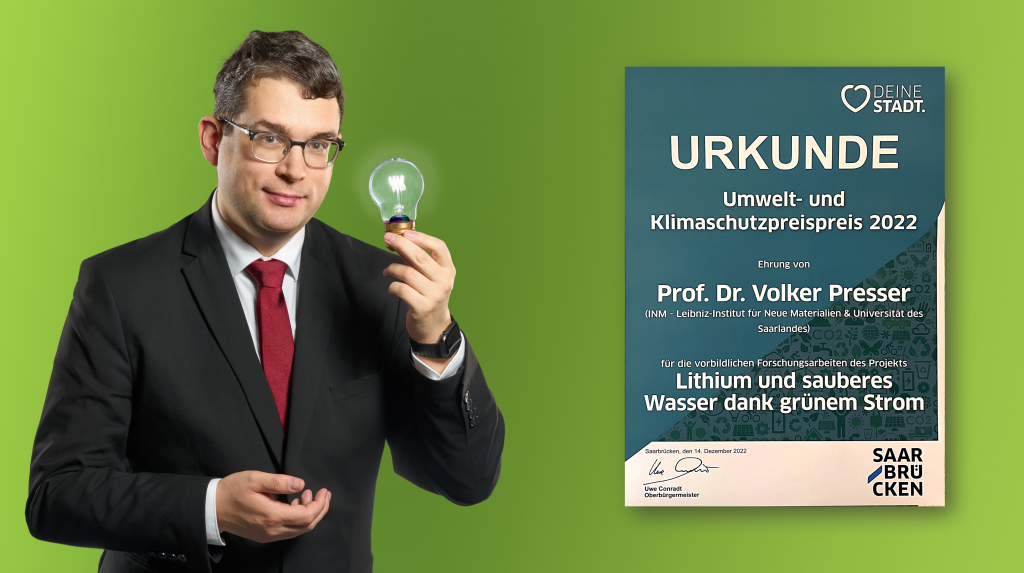
Volker Presser was honored for the work on electrochemical water remediation and Lithium-ion extraction by the City of Saarbrücken. Read more about the event and all awardees.

Volker Presser presents our team’s work on Lithium-ion harvesting from aqueous media, including mine water, at a symposium organized by the Saarlandian Chamber of Commerce and Industry (IHK) on circularity and battery recycling.
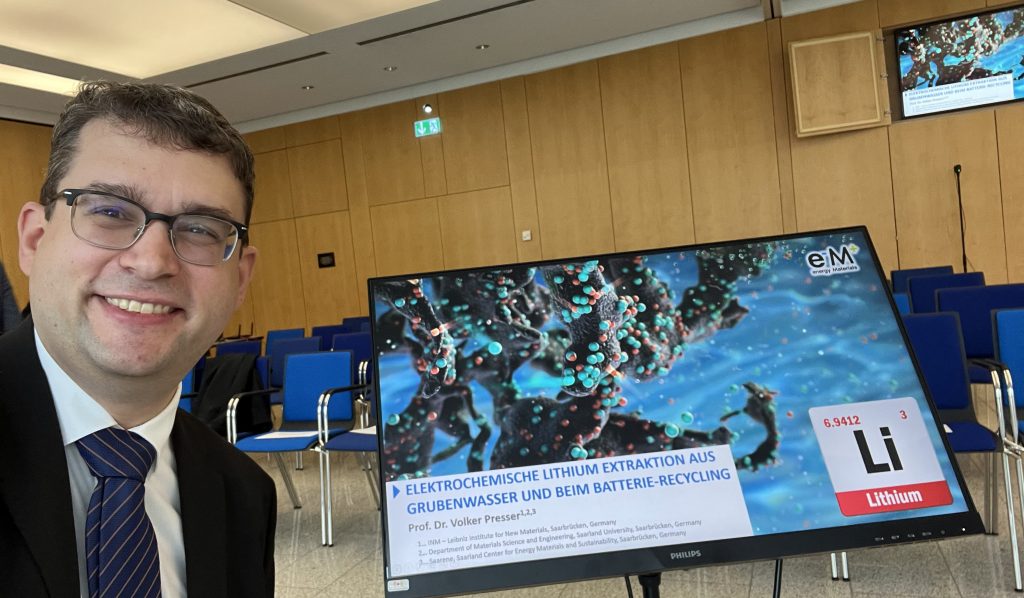
Our work on lithium-ion recovery from aqueous media (including seawater) was featured by the local radio station SR3.
https://www.sr.de/sr/sr3/themen/panorama/wissenschaftler_leibniz_institut_lithiumgewinnung_100.html
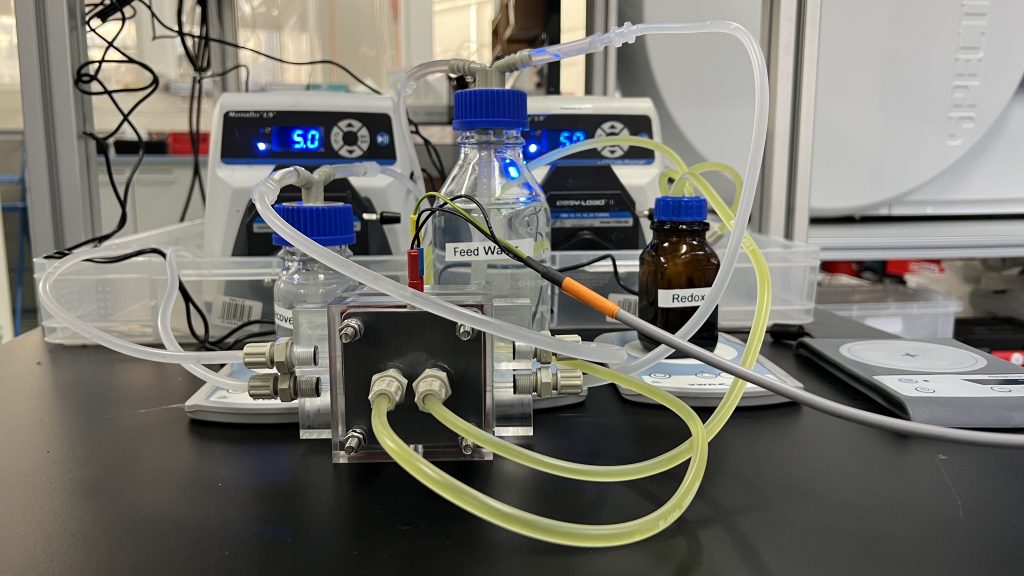
It is a privilege to receive, after 2018 and 2021, the recognition as 2022 Highly Cited Researcher (HRC) by Clarivate. Only 6,938 out of abut 8M researchers have received this recognition. Citation numbers are not the most important parameter in science, but I am grateful to our team and collaborators that the community so well receives our works. I am also honored to be the only 2022 HRC of Saarland University and only 1 of 2 if counting the University Hospital, too.
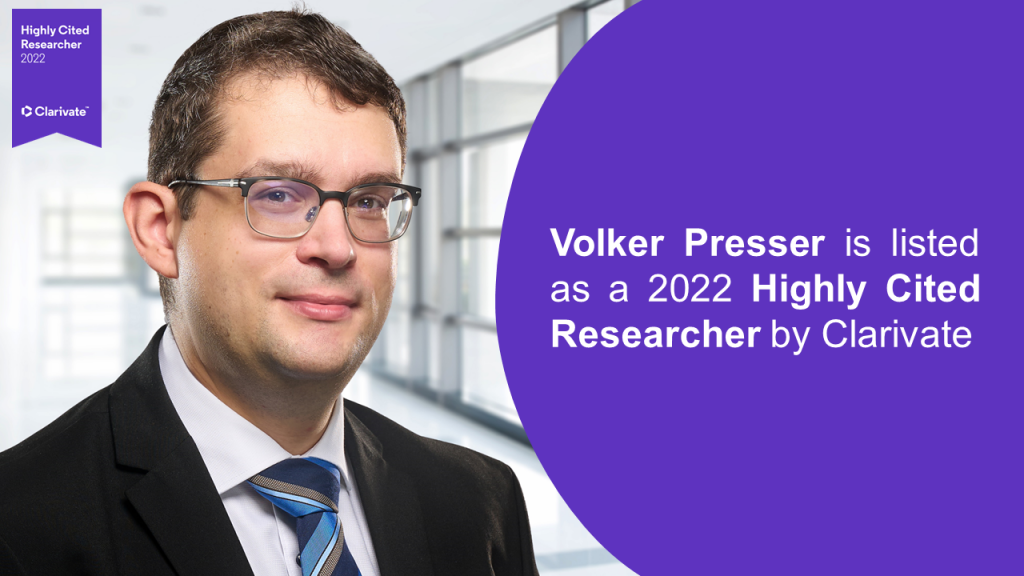
New paper published in Carbon. This is our latest work from our collaboration with our Austrian partners now being published in the January issue of Carbon. Combining the expertise in catalysis of the Eder group (TU Vienna) with the innovative carbon spherogel material developed by Michael Elsaesser from the Hüsing Group (Paris Lodron Universität Salzburg) makes up for an interesting system. Spherogels are hollow carbon spheres which, as shown by this work, can be conveniently loaded with electrocatalytically active species, such as titania. In our case, we studied the photocatalytic hydrogen evolution.
After a lot of work by our Ph.D. students Stefanie Arnold and Lei Wang, our invited article in the Wiley journal SMALL on the dual-use of seawater batteries for energy storage and water desalination. Seawater batteries are a unique type of device that capitalizes, in the most common design, on a ceramic separator, an electrocatalytic reaction on one electrode side, and reversible sodium-ion electrochemistry on the other side. Since simple seawater can be used as the aqueous electrolyte in the system, the system has become known as seawater batteries. In our opinion, this technology can do more than contribute toward beyond-lithium energy storage by also being used for desalination.
New paper published in ACS Omega. Batteries employing transition-metal sulfides enable high-charge storage capacities, but polysulfide shuttling and volume expansion cause structural disintegration and early capacity fading. The design of heterostructures combining metal sulfides and carbon with an optimized morphology can effectively address these issues. Our work introduces dopamine-coated copper Prussian blue (CuPB) analogue as a template to prepare nanostructured mixed copper–iron sulfide electrodes. The material was prepared by coprecipitation of CuPB with in situ dopamine polymerization, followed by thermal sulfidation. Dopamine controls the particle size and favors K-rich CuPB due to its polymerization mechanism. While the presence of the coating prevents particle agglomeration during thermal sulfidation, its thickness demonstrates a key effect on the electrochemical performance of the derived sulfides. After a two-step activation process during cycling, the C-coated KCuFeS2 electrodes showed capacities up to 800 mAh/g at 10 mA/g with nearly 100% capacity recovery after rate handling and a capacity of 380 mAh/g at 250 mA/g after 500 cycles.
I am honored to receive the 2022 Zhaowu Tian Prize for Energy Electrochemistry. This award by the International Society of Electrochemistry recognizes the achievements in the field of electrochemistry for energy of my team and I. I am fortunate to join the list of awardees which includes from past years Xiangfeng Duan (2017), Fabio la Mantia (2018), Zhichuan (Jason) Xu (2019), and Joaquín Rodríguez-López (2021). Coming in the year of my 40th birthday and the 10-year-anniversary of being a PI at the INM – Leibniz Institute for New Materials, I am grateful to not just my team but also our esteemed collaborators, especially dear friends such as Michael Naguib, Guang Feng, Christian Prehal, Yury Gogotsi, Veronica Augustyn, and so many more!
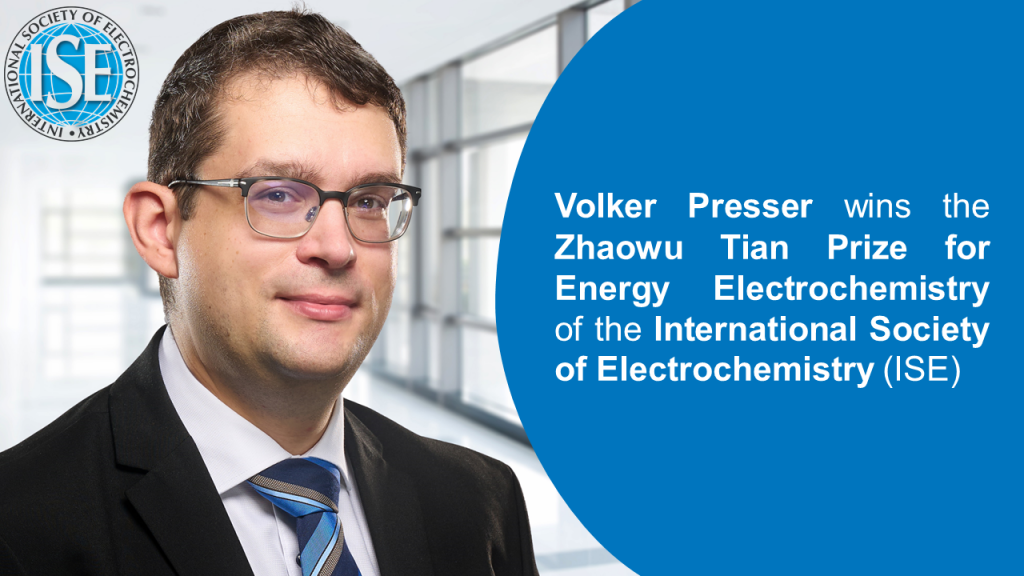
New paper published in Electrochimica Acta on Ni-decorated AgAu alloy graphene/cobalt hydroxide electrodes for micro-supercapacitors to obtain high-performance micro-supercapacitors. A nanocomposite of graphene, cobalt hydroxide and nickel can was obtained from using gold-silver alloy lines. Using a two-step electrodeposition method, the scaly morphology is pre-deposited on a Ni film, followed by the interconnecting corrugated graphene/cobalt hydroxide composite nanomaterial. The resulting device, a graphene/cobalt hydroxide/Ni//activated carbon flexible micro-supercapacitor (MSC), was assembled by gel KOH-PVA electrolyte, graphene/cobalt hydroxide/Ni (positive electrode), and activated carbon (negative electrode). When testing, we obtained a volumetric energy of about 19 mWh/cm3 and the devices retained over 94% capacitance after 10,000 cycles. After 1,000 continuous bending/unbending cycles at a 180° bending angle with the frequency of 100 mHz, the capacitance retention of MSC is still maintained at 97% of the initial value.
Welcome to our new Postdoc Dr. Kaitlyn Prenger! Kaitlyn is a graduate of Tulane University from the esteemed team of Michael Naguib and will work on novel 2D (and other) materials for sustainable electrochemical applications.
Stefanie Arnold gives an oral presentation with the title “Design Matters: The Path to High-Performance Antimony / MXene Hybrid Electrodes for Sodium-Ion Batteries” at the MSE2022 conference in Darmstadt. This was joint work with Riccardo Ruffo‘s team and Stefano Marchionna (Italy).
new paper published in ACS Energy Letters on continuous electrochemical lithium-ion extraction. We used a redox electrolyte “engine” to drive the ion transfer (in our case: potassium ferricyanide). Employing a pair of ceramic lithium superionic conductor (LISICON) membranes meant that only Lithium ions were accessible to the redox electrolyte for charge compensation. And to complement the design, we used an anion exchange membrane to separate the inflow (e.g., seawater) from a recovery solution. By this way, we obtained an electrochemical system for the continuous extraction of Lithium ions. This sets this technology apart from earlier works (including our contributions) that relied on a cyclic operation to obtain ion separation. Yet, this is just one of many more steps towards seeing such technology toward application; future research must critically address cell design, optimization of the Li-membranes, and investigating the robustness and durability of continuous operation.
This work was the result of the collaboration of our Ph.D. students Lei Wang, Stefanie Arnold, Panyu Ren, and our former Postdoc (now group leader at Bavarian Center for Battery Technology (BayBatt)) Qingsong Wang, as well as our Chinese collaborators Jun Jin and Zahoyin Wen (Chinese Academy of Sciences).
New paper published in Materials Futures. Sodium-deficient, P2-type layered oxides are promising cathodes for sodium-ion batteries. Their open sodium cation transport pathways lead to low diffusion barriers and enable high charge/discharge rates. However, a phase transition from P2 to O2 structure occurring above 4.2 V and metal dissolution at low potentials upon discharge results in rapid capacity degradation. In this work, we demonstrate the positive effect of configurational entropy on the stability of the crystal structure during battery operation. The high-entropy cathode material shows lower structural transformation and Mn dissolution upon cycling in a wide voltage range from 1.5 V to 4.6 V. Advanced operando techniques and post-mortem analysis were used to thoroughly probe the underlying reaction mechanism. Overall, the high-entropy strategy is a promising route for improving the electrochemical performance of P2 layered oxide cathodes for advanced sodium-ion battery applications.
Behnoosh Bornamehr gives an oral presentation on her research on electrospinning. Her talk is aptly titled “Too fast, too brittle: a study on heat treatment parameters for free-standing vanadium oxide electrodes”.
New paper published in Desalination on the ion selectivity of carbon nanopores. It is well known that electrolyte confinement inside carbon nanopores strongly affects ion electrosorption in capacitive deionization. A thorough understanding of the intricate pore size influence enables enhanced charge storage performance and desalination in addition to ion separation. In subnanometer pores, where the pore size is smaller than hydrated ion size, a dehydration energy barrier must be overcome before the ions can be electrosorbed into the pores. Ion sieving is observed when the dehydration energy is larger than the applied energy. However, when a high electrochemical potential is used, the ions can desolvate and enter the pores. Capitalizing on the difference in size and dehydration energy barriers, this work applies the subnanometer porous carbon material, and a high electrochemical ion selectivity for Cs+ and K+ over Na+, Li+, Mg2+, and Ca2+ is observed. This establishes a viable way for selective heavy metal removal by varying pore and solvated ion sizes. Our work also shows the transition from double-layer capacitance to diffusion-limited electrochemical features in narrow ultramicropores.
Welcome new Ph.D. student Jean Gustavo De Andrade Ruthes! Jean is from the Universidade Federal do Paraná, Brazil, and will be working on MXene / graphene batteries within our Czech-German research collaboration.
Welcome visiting student Esmeralda Lopez Toro! Esmeralda is from the Universidad de Santiago de Chile and will work with us on electrospinning.
Welcome to our new student intern, Anna Quinten! Anna is from Saarland University and will be working on ionic liquid supercapacitors.
Welcome new Postdoc Dr. Delvina Japhet Tarimo! Delvina is from University of Pretoria, South Africa, and will be working on nanoporous materials and next-generation batteries.
Chandrasekaran Sakthi Vigneshwaran is a Master student working on next-generation Prussian blue based electrode materials for advanced batteries. Congratulations on being awarded a three month fellowship by the StudienStiftungSaar!